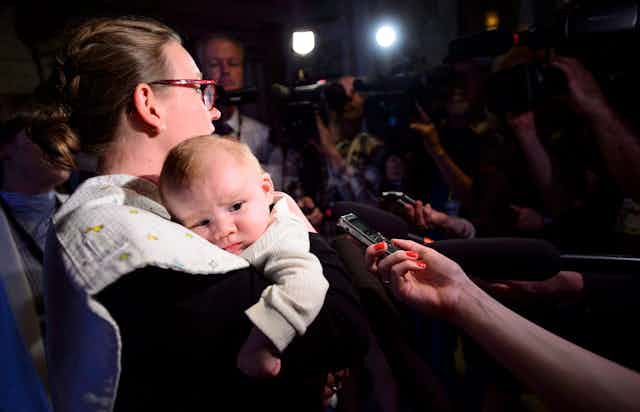Federal cabinet minister Karina Gould, leader of the government in the House of Commons, has made Canadian history three times: as the youngest female federal cabinet minister, the first to give birth while holding office and the first to take parental leave. Her approach to parental leave could well translate into her most enduring legacy.
Like all MPs, Gould wasn’t eligible for parental leave when her first child was born in 2018. Four weeks later, she resumed work in her constituency of Burlington, Ont. After another five weeks, she returned to the House of Commons with her infant in tow.
Gould has just given birth to her second child. This time, she’s doing things differently. She’s taking six months off, thanks to 2019 legislation that provides MP parents of newborns up to 12 months with paid parental leave benefits.
On the surface, Gould’s parental leave plan resembles that of many Canadians. Yet there are key differences, and they offer three lessons on how parental leave could be redesigned for each and every Canadian parent.
Lesson 1: Boost eligibility
Not all Canadians are eligible for parental leave. Almost one-third of all Canadian mothers (outside of Québec, which has a more inclusive program) do not receive paid maternity or parental benefits. This is due to many factors, including restrictive eligibility criteria of 600 employment hours in the year before a child’s birth.
MPs do not pay into Employment Insurance (EI) and so were, until 2019, ineligible for parental leave benefits. Yet the government found a policy path for them.
It’s time to rethink eligibility criteria so that more Canadians can benefit from parental leave benefits.
Lesson 2: Better wage top-ups
MPs receive 92 per cent of their salaries while on leave. Similar salary top-ups exist in the public sector and some private companies. For most Canadians, however, parental leave is low-paid: only 33 to 55 per cent of wages, with a ceiling of $401 to $668 weekly and $63,200 annually.
Out of 36 countries in the Organisation for Economic Co-operation and Development, Canada has the lowest wage replacement rates for parental leave.
This has implications for how many Canadian fathers take their parental leave entitlements. In 2020-21, 23.5 per cent of eligible fathers took parental leave. In Québec, which has a 70-75 per cent wage replacement rate, that number was 85.6 per cent. It’s time to make leaves affordable for all parents.
Lesson 3: More flexibility
Finally, there are lessons about flexibility and choice, and what they mean in a post-pandemic world, where remote work has changed how people balance family life and paid work.
For Gould, this means taking a short post-partum leave and then combining parental leave with some remote work. As she told Canadians, she plans to “take on her MP work remotely, voting and participating in caucus and cabinet meetings, though on a reduced schedule.”

Admittedly, an MP’s job, with its unique pressures, requires a flexible parental leave system. Yet many other jobs have distinct demands.
The problem with Canada’s current system is that leaves must be taken as consecutive weeks in the first 12 to 18 months after a child’s birth.
There are other ways to do parental leave. In Sweden, for example, leaves can be taken in one or several blocks of time, in days rather than weeks, on a full or part-time basis, and across several years.

There are risks to flexible leave, however, that are well-documented in research on flexible work and gender inequalities. Some employers might not respect the boundaries of parents on leave. These boundaries are critical because parents need time to care for their infants, who demand and deserve that dedicated care.
But there are precedents to build on, such as Ontario’s “right to disconnect” policy and EI’s Working While on Claim option.
Shining a spotlight
Gould’s parental leave matters not only to her family. It should matter to all Canadians, because it shines a spotlight on the federal government’s long overdue promise to rethink and redesign parental leave policy.
There have been important changes, including a parental sharing benefit for fathers and second parents and benefits for parents of adopted children. It’s time to do more for more Canadians.
A rethinking of parental leave should begin with clarifying what parental leave is.
Currently, a paid leave to care for an infant combines parental benefits, which are lodged within EI as employment benefits, and the right to take job-protected leave, which is part of provincial/territorial/federal employment standards.
Read more: Improved employment policies can encourage fathers to be more involved at home
But parental leave is more than an employment policy — it’s also a care policy. Despite what the EI website states, a leave to care for an infant is not about being “away from work.” Care work is, in fact, actual work.
Parental leave also needs to be integrated with other care policies, especially early learning and child-care policies. Again, there are models to emulate, such as Sweden and other Nordic countries. There, children have a human right and entitlement to be cared for.
And there is an explicit policy aim that for every child, there will be no gap between the end of well-paid parental leave and the beginning of early learning and child care.

Recognizing the value of care
The COVID-19 pandemic had major impacts on how some Canadians, including MPs, can now do some of their paid work in the office or at home. The pandemic also illuminated the socioeconomic value of care and the care economy.
Gould understands this. As the former minister of families, children and social development, she worked with child-care advocates and experts to shepherd the creation of Canada’s first national child-care program.
When she returns from her parental leave, she will be well-placed to advocate for more inclusive integrated care policies. In fact, it may be long overdue to create a federal minister of care.

